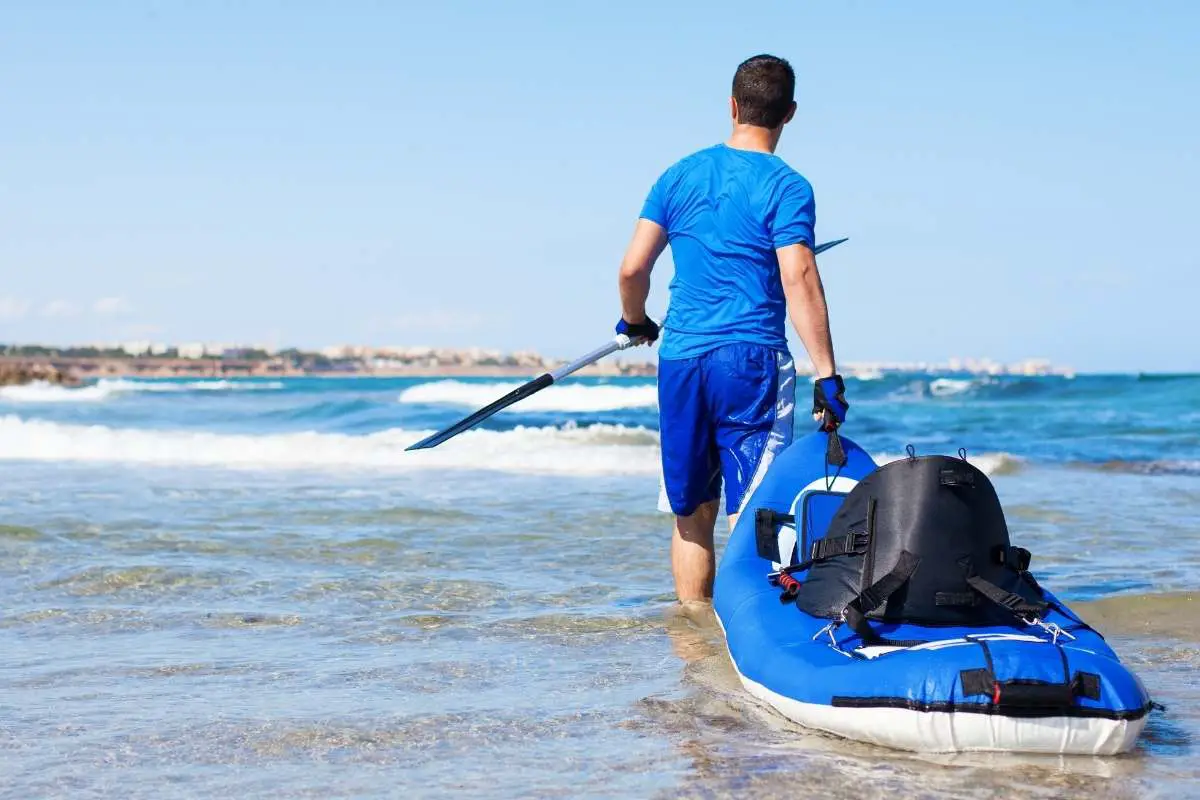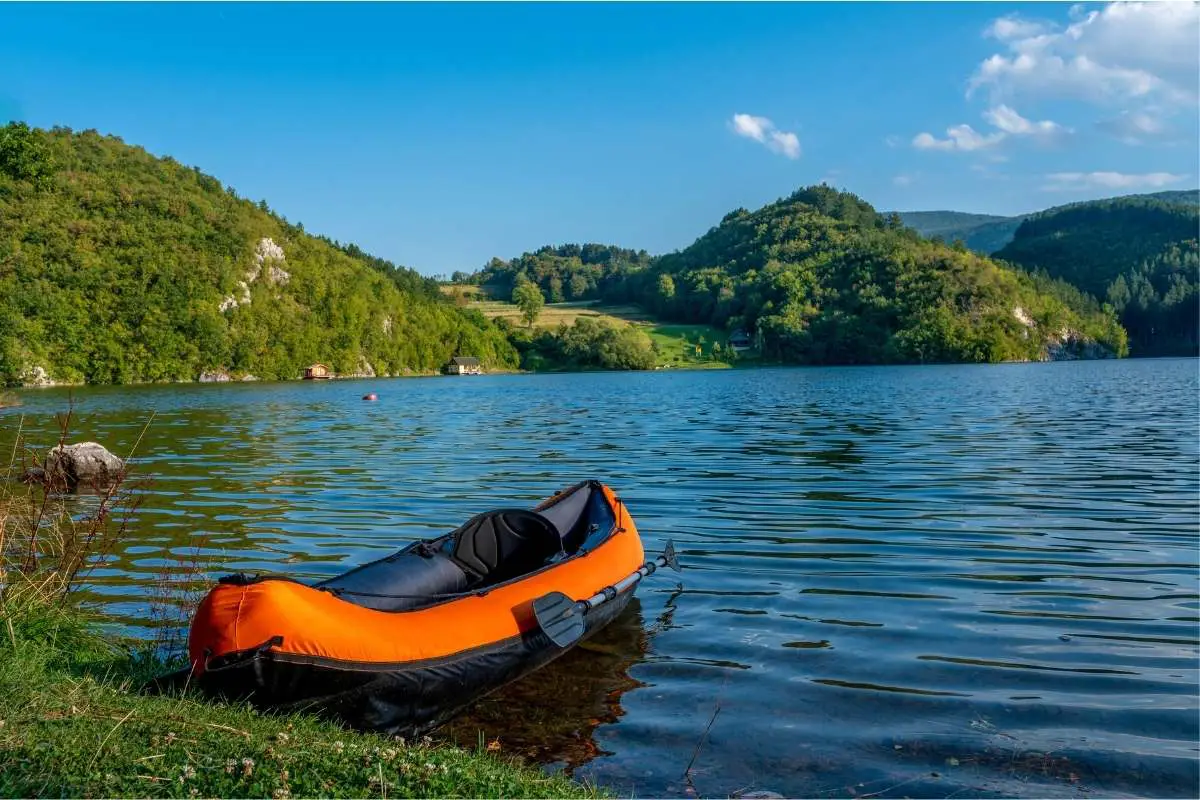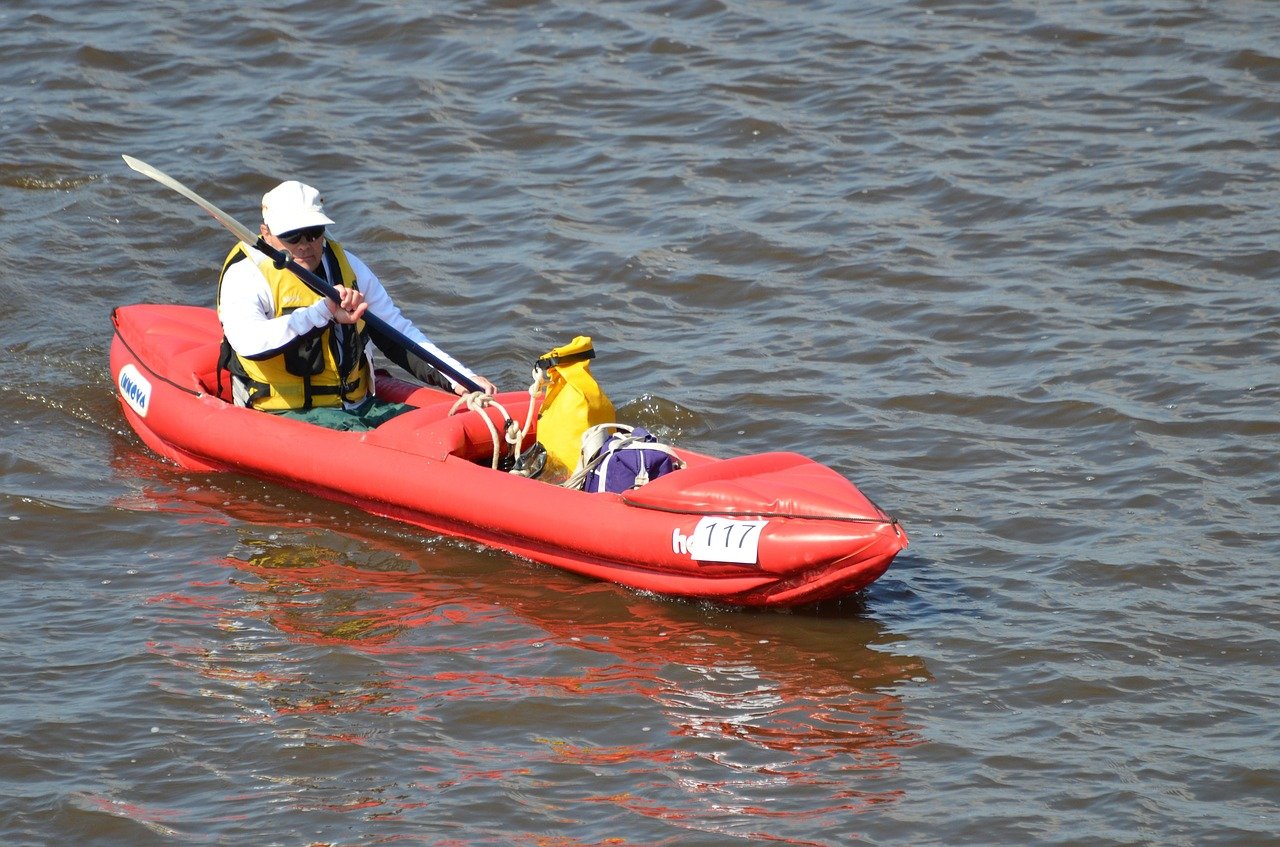Are New England’s endless waterways calling to you? Well, there’s no better way to explore them than by kayak! With a paddle in your hands and the sun above your head, you glide across the water, feel immersed in nature, and gain a unique vantage point far from the crowds even in the height of the summer tourist season. Inflatable kayaks help lots of people experience the joys of kayaking in New England. If you’re thinking of buying kayaks and want to learn more about inflatable kayaks, we have everything you need to know about these blow-up watercraft including the advantages of inflatable kayaks vs hardshell.
Table of Contents
Inflatable Kayaks vs Hardshell
Standard hardshell kayaks aren’t without their downsides. Rigid kayaks may be tricky to transport,You will need a roof rack or a trailer to carry them around. For example, you will need to add the extra cost if you are going to Martha’s Vineyard or Nantucket because the Steamship Authority charges more for bigger vehicles and trailers than smaller cars.
Hardshell kayaks are also heavier to transport because of the materials from which they are created. Typically you need two people to carry a hardshell kayak which can be inconvenient if you are the only adult with children in tow.
Hardshell kayaks also require a lot of storage space at home. You can always leave your hardshell kayaks in your vacation home but that’s not practical if you are renting a vacation home. Inflatable kayaks can fit into the back of your car or in your garage.
Likewise, if you don’t plan on hitting the water very often, the thought of splashing out (if you’ll pardon the pun) on one might be less than enticing too. My children love kayaking but may only kayak a couple of times a week. We would have to kayak a lot more on summer vacations to cover the cost of a rigid kayak.
Inflatable kayaks are convenient blow-up watercraft that can address your concerns about price, storage, transportability and weight.
Inflatable Kayak Safety
We know my biggest concern with buying inflatable kayaks was safety. After all, hardshell kayaks (also known as rigid kayaks) are made from wood, plastic, fibreglass or composite materials.
What if the inflatable kayak punctured and my beloved kids were tossed into the water as they drift into the horizon?
First of all, like with all kayaks, everyone in a kayak should wear life vests.
Also, however, the newer models of inflatable kayaks are puncture resistant. They have extra air chambers that reduce the risk of tears and leaks in an inflatable kayak.
In fact, certain types of inflatable kayaks can now even be used for whitewater rafting. The key is to make sure that the type of inflatable kayak you purchase is indeed appropriate for what you are doing with it.
Read on to discover everything worth knowing about inflatable kayaks.
The Advantages of Inflatable Kayaks
Inflatable kayaks resemble rigid ones in almost every way. They have the same general shape and style- with a bow, stern, seat, and paddle.
The only difference? They’re made from multi-layered PVC or special types of rubber rather than wood, plastic, Kevlar, or fiberglass. This allows you to inflate and deflate them.
Here are the main advantages of inflatable kayaks:
Lightweight
An average rigid kayak weighs somewhere around 60lbs (although many are considerably heavier). By comparison, a typical 1-person inflatable kayak weighs around 30lbs. This doesn’t matter so much in the water, but it makes a significant difference when you’re carrying, lifting, and shifting your kayak from place to place!

Inflatable kayaks are easily transported and moved around.
Portable
Inflatable kayaks aren’t just lighter, they’re also much smaller. After all, you can deflate them!
Whenever you aren’t using it, you simply let out the air and roll it up. Transporting your kayak to the nearest lake, river, pond, or beach becomes a breeze in the process.
There’s no roof rack or trailer required. Roughly the size of a suitcase, you can put it in the trunk and then carry it to the water’s edge.
Easy to Store
Inflatable kayaks are also perfect for people with limited storage space at home. The fact you can deflate them means they’ll fit almost anywhere, no matter how full your basement, attic, or garden shed already is!
For the same reasons, you don’t need to invest in any special racks or containers (as you often do for hardshell kayaks).
The inflatable kayak we have comes in its own carrying case making it super easy to pack away and to identify amongst the boxes of storage.
Affordable
Because inflatable kayaks don’t use any of the expensive materials found in rigid models (e.g. fiberglass or wood), they tend to be much more affordable too. While high-end options certainly aren’t cheap, you can expect to pay significantly less than you would for a hardshell kayak of similar quality.
Practical
Inflatable kayaks are arguably the best beginner kayaks on the market- not to mention an awesome choice for casual paddlers.
Stable, easy to get in and out of, hard-wearing, and extremely forgiving (read: unlikely to tip), they’re suitable for people of all ages, including your kids!
We had assumed that once our kids had decided if they really liked kayaking, we would get “real” fibreglass kayaks. Now, we like our inflatable kayaks so much that we are sticking with these types of kayaks indefinitely.
The Disadvantages of Inflatable Kayaks
Don’t rush to hit the “buy button” just yet though! There are a few disadvantages of inflatable kayaks worth knowing about too.
Must Be Inflated
One benefit of rigid kayaks is that there’s no work to do upon arriving at the water! You put them straight in the water, sit down, and away you go.
With an inflatable kayak, though, you have to blow it up first. This certainly isn’t the end of the world, but it can feel like an inconvenience when you’re desperate to start paddling.
Potential for Mold
It’s super important to dry an inflatable kayak thoroughly after you use it.
If you don’t, then you could end up with mold growing on the surface where pockets of water have remained (especially if you leave it in storage for an extended period).
Performance
For all their convenience and practical advantages, inflatable kayaks don’t always perform as well on the water compared to hardshell models.
Remember, they’re lighter!
That’s useful when you’re carrying them, but it can make them harder to control in rough conditions (e.g. when there’s wind and waves).

An inflatable kayak lets you escape the crowds and explore hard to reach places.
Types of Inflatable Kayaks
There are a few main types of inflatable kayaks on the market. While their general design and attributes remain the same, they each have a slightly different purpose. In this section, we’ll run through each one in turn:
Inflatable 1 Person Kayaks
As the name suggests, these kayaks are designed with the solo paddler in mind! They only have space for one person, which makes them the smallest and lightest types of kayaks available.
Inflatable Tandem Kayaks (2 Person Inflatable Kayaks)
Tandem kayaks are designed for 2 paddlers (with one sitting in front of the other). Tandem kayaks are longer, wider, and heavier to boot.
If you’re buying one to enjoy as a family, then 2 person inflatable kayaks are probably the best bet.
Inflatable Fishing Kayaks
There’s nothing stopping you from taking your fishing rod out on a standard inflatable kayak (many people do!).
However, specially-made inflatable fishing kayaks are kitted out with anglers in mind, often boasting extra reinforcement in certain areas for more strength, functionality, and durability.

You can get inflatable fishing kayaks if you intend to go fishing a lot.
Important Factors to Consider When Buying Kayaks
How do you choose the best inflatable kayak for you? Here are the considerations you should keep in mind while you search for the right inflatable kayak.
Size
The size of inflatable kayaks doesn’t just depend on how many people they’re designed to carry. It relates to performance as well.
For example, longer kayaks have more storage space and tend to cruise more efficiently through the water, whereas shorter hulls are easier to turn.
Likewise, kayaks with wider hulls are more stable, but harder to maneuver.
If safety’s your priority, then opt for a wider inflatable kayak over a nimbler and narrower one.
Weight
Two factors are important to keep in mind here: the weight of the kayak and the weight they’re designed to carry!
Make sure you buy an inflatable kayak that a) is light enough for you to carry with ease and b) has a weight capacity suitable for the people in your family plus any gear you wish to take into the boat.
Materials
Most inflatable kayaks are made from PVC, which is durable, long-lasting, easy to patch, and relatively inexpensive. However, it’s also susceptible to damage from UV rays and can struggle in extreme temperatures!
Pennel Orca is another common material that is a synthetic rubber. Resistant to abrasion, UV rays, and extreme temperatures (as well as chemicals), these kayaks end up being incredibly tough. Kayaks make from Pennel Orca are ideal for white water and have a longer warranty period. On the flip side, inflatables made from Pennel Orca are also much more expensive.
Then there’s nitrylon, which is a combination of synthetic and natural rubber over polyester fabric. Bringing together many of the attributes of PVC and Pennel Orca, kayaks made from nitrylon is also very heavy.
Ultimately, however, the best material for your kayak depends on your budget and what you intend to do with it.
Number of “Skins”
Another related factor to consider is how many layers (or “skins”) of material the kayak has.
Single-skin kayaks are the cheapest, although they’re also more susceptible to damage.
Although more layers (i.e. dual or triple-skinned) lead to a more stable, durable, and comfortable kayak, multi-layers will increase the price.
Purpose
Think about what you’ll be using your kayak for.
- Is it for family fun on a casual mooch around ponds and beaches?
- Or do you want to go on longer kayak trips and need to carry extra gear?
- Will you want to have more extreme adventures like on white water?
Your answer will dictate the type of kayak you need. For instance, a cheaper, lightweight, and lower-quality model should suffice for casual use.

Make sure you have room in your inflatable kayak for your best friend!
Price
While the majority of these kayaks are more affordable than their rigid counterparts, the best inflatable kayaks don’t come cheap!
While you do get what you pay for, there’s little point in overspending on a model that has fancy features you don’t really need.
The Best Inflatable Kayak Manufacturers
Sticking to trusted manufacturers is the best way to ensure you buy a quality kayak. In the US, a few of the best-known brands in the industry are:
- Sea Eagle
- Advanced Elements
- Driftsun
- Intex
- Sevylor
Inflatable Kayak Maintenance Advice
Wondering how to take proper care of your inflatable kayak? Here are 5 quick-fire tips that should ensure you get years of fun from your purchase:
Dry After Each Use
Avoid mold by drying your kayak off as thoroughly as possible whenever you leave the water.
The simplest way to do it is by leaving the kayak inflated while you use a towel to remove the water.
Don’t forget to flip it upside down to get any water out of the cockpit.
You can then deflate it and remove any final moisture you can see with a towel before putting it back in storage.
Store in a Cool, Dry Place
Keeping your kayak out of the elements and in a cool, dry place (e.g. a garage or closet) will help to preserve the materials. Inside is usually best.
Want to keep your kayak inflated? Try to ensure it’s kept off the floor.

This case for an inflatable kayak has carry handles that make it easy to store and to transport.
Transport with Care
Try to be just as careful when you’re transporting the kayak from place to place. The last thing you want is to drag it across anything sharp that could damage (or puncture) the materials.
Keep an eye out for debris that could cause trouble when you’re in the water.
Apply Protective Spray
UV rays can damage the materials of inflatable kayaks over time. Avoid that fate by applying 303 protectant spray to the surface once or twice a year.
Inflatable Kayak FAQs
Here are some frequently asked questions many people have about inflatable kayaks.
How Stable Are Inflatable Kayaks?
Extremely!
Inflatable kayaks (particularly lower-end models designed for casual use) tend to be much less wobbly than hardshells.
With their wide bottoms (some are up to 40” wide) and multiple air chambers, they’re well-balanced and very difficult to tip. The larger and wider you go, the more stable they become.
Are Inflatable Kayaks Safe?
While there’s always danger involved when you’re out on open water, the stability and ease of use involved with inflatable kayaks make it very unlikely you’ll have any problems (particularly on calm days).
You can make things even safer by avoiding rough water, staying close to shore, and keeping the kayak well-maintained to ensure the materials stay strong over time.
Do They Puncture Easily?
Thankfully not! Punctures are rare, but the chances of getting one do increase with cheaper models (due to them having fewer layers of lower-quality materials).
You should be fine if you take care and avoid dragging your kayak over sharp objects.
Can You Get In and Out Easily?
Yes! Because inflatable kayaks tend to be so stable in the water, you shouldn’t struggle to get in and out (regardless of your age or skill level!).
If you’re worried about this, then try to do it from the shoreline instead of a dock. Asking someone to hold the kayak while you get in and out will be a big help too.
How Do You Secure Gear?
Most inflatable kayaks have either a bungee rope section or d-rings with which you can strap things in place or tie them down.
Depending on the type of inflatable kayak you buy, there might also be space in the cockpit.

A two person kayak with gear secured easily.
Can You Use an Electric Pump?
Absolutely. Most inflatable kayaks on the market will come with a foot or a hand pump anyway, but an electric one is definitely the easier approach! Just make sure you don’t over-inflate it.
Can They Cope in White Water?
Sometimes, but not always. You’ll need to buy an inflatable kayak that’s been designed with this in mind! These kayaks are much more durable and hard-wearing, but they cost much more as well.
Time to Buy an Inflatable Kayak?
We hope this guide has given you all the information you need about inflatable kayaks! These versatile watercraft make kayaking more accessible than ever, but there’s a lot to learn to ensure you buy one that’s right for your needs.
Keep these insights in mind and it shouldn’t be long before you’re happily drifting across the water with a paddle in hand.
To find out about the best inflatable kayaks on the market, don’t forget to read our buying guide too!
SPREAD THE WORD! PIN THIS TO YOUR TRAVEL PINTEREST BOARDS FOR FUTURE REFERENCE!
We did not receive compensation of any form, monetary or otherwise, from any of the products, services, hotels etc mentioned in this article.
This site generates income via partnerships with carefully-curated travel and lifestyle brands and/or purchases made through links to them at no extra cost to you. More information may be found on our Disclosure Policy.

Leave a Reply